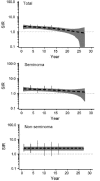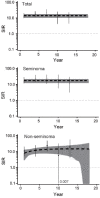Risk of second primary cancers after testicular cancer in East and West Germany: a focus on contralateral testicular cancers
- PMID: 24407180
- PMCID: PMC3955342
- DOI: 10.4103/1008-682X.122069
Risk of second primary cancers after testicular cancer in East and West Germany: a focus on contralateral testicular cancers
Abstract
Testicular cancer survival rates improved dramatically after cisplatin-based therapy was introduced in the 1970s. However, chemotherapy and radiation therapy are potentially carcinogenic. The purpose of this study was to estimate the risk of developing second primary cancers including the risk associated with primary histologic type (seminoma and non-seminoma) among testicular cancer survivors in Germany. We identified 16 990 and 1401 cases of testicular cancer in population-based cancer registries of East Germany (1961-1989 and 1996-2008) and Saarland (a federal state in West Germany; 1970-2008), respectively. We estimated the risk of a second primary cancer using standardized incidence ratios (SIRs) with 95% confidence intervals (95% CIs). To determine trends, we plotted model-based estimated annual SIRs. In East Germany, a total of 301 second primary cancers of any location were observed between 1961 and 1989 (SIR: 1.9; 95% CI: 1.7-2.1), and 159 cancers (any location) were observed between 1996 and 2008 (SIR: 1.7; 95% CI: 1.4-2.0). The SIRs for contralateral testicular cancer were increased in the registries with a range from 6.0 in Saarland to 13.9 in East Germany. The SIR for seminoma, in particular, was higher in East Germany compared to the other registries. We observed constant trends in the model-based SIRs for contralateral testicular cancers. The majority of reported SIRs of other cancer sites including histology-specific risks showed low precisions of estimated effects, likely due to small sample sizes. Testicular cancer patients are at increased risk especially for cancers of the contralateral testis and should receive intensive follow-ups.
Figures


References
-
- Jemal A, Bray F, Center MM, Ferlay J, Ward E, et al. Global cancer statistics. CA Cancer J Clin. 2011;61:69–90. - PubMed
-
- Bray F, Richiardi L, Ekbom A, Pukkala E, Cuninkova M, et al. Trends in testicular cancer incidence and mortality in 22 European countries: continuing increases in incidence and declines in mortality. Int J Cancer. 2006;118:3099–111. - PubMed
-
- Stang A, Rusner C, Eisinger B, Stegmaier C, Kaatsch P. Subtype-specific incidence of testicular cancer in Germany: a pooled analysis of nine population-based cancer registries. Int J Androl. 2009;32:306–16. - PubMed
-
- Dieckmann KP, Pichlmeier U. Clinical epidemiology of testicular germ cell tumors. World J Urol. 2004;22:2–14. - PubMed
-
- Horwich A, Shipley J, Huddart R. Testicular germ-cell cancer. Lancet. 2006;367:754–65. - PubMed
Publication types
MeSH terms
Grants and funding
LinkOut - more resources
Full Text Sources
Other Literature Sources
Medical

